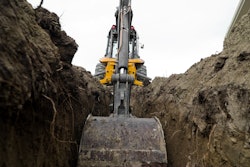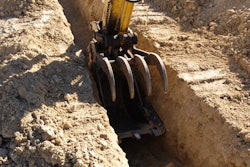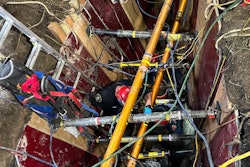
A natural-gas line struck last month in Missouri before an explosion killed a 5-year-old boy was not marked by the utility company’s locating service, according to a new report from the National Transportation Safety Board.
The explosion and resulting fires April 9 in Lexington occurred after a subcontractor installing an underground fiber-optic line “drilled into an unmarked section of a capped underground gas distribution main,” the NTSB says in a preliminary report. The NTSB is investigating the incident that destroyed a home and damaged two others. A 5-year-old boy was killed, and his father and 10-year-old sister were severely burned.
Five days before the explosion, the subcontractor, Alfra Construction, called Missouri 811 to mark any buried utilities, according to the report. Alfra was hired by Sellenriek Construction for the project.
Liberty Utilities, a subsidiary of Algonquin Power and Utilities Corp. that operated the gas main, sent a locator to mark its utilities and reported it had finished the work April 7.
“The location of the uncapped gas main section involved in the accident was not identified or marked during this process,” NTSB says.
 Alistair Lamb, 5, died in the explosion. His 10-year-old sister, Cami, and father Jake Cunningham were severly injured.GoFundMe fnudraiser page for family
Alistair Lamb, 5, died in the explosion. His 10-year-old sister, Cami, and father Jake Cunningham were severly injured.GoFundMe fnudraiser page for family
At about 4 p.m. April 9, an Alfra worker felt the drill strike an object, and a natural-gas odor was soon detected. The crew supervisor called 911 and 811.
Liberty Utilities personnel tried to “squeeze off” the main, which involves compressing pipes at one or more locations, but couldn’t stop the gas flow. The main was a 4-inch polyethylene pipe operating at pressure of 30 psi and had a max pressure of 35 psi. Lexington Fire Department personnel were also on the scene.
Liberty called for the evacuation of a business 15 feet from the leak. Other buildings or residences within 80 to 160 feet from the leak were not evacuated.
The explosion occurred at 7:42 p.m., more than three hours after the leak was detected. Liberty isolated the main at about 8:10 p.m.
In response to NTSB’s report, Sarah K. Magruder Lyle, president and CEO of the nonprofit Common Ground Alliance, urged utility owners, locators and excavators to follow the alliance’s best practices for digging around buried lines.
“Accurately locating and marking underground utilities relies on accurate maps of those utilities,” she said. “Buried infrastructure owners and operators must commit to follow nationally recognized best practices to prevent these tragedies. That includes ensuring utility maps are up-to-date and that every utility line is marked, every time.”
The state of Missouri sees more than 1,000 incidents of damage to buried utilities each year, according to CGA, which also reports that utility line locating errors are among the top causes of underground utility damage.
The alliance also noted that after the deadly explosion, the Missouri Senate passed CGA’s Best Practices.
{Related Content: Missouri AG Sues Utility for Alleged Unmarked Gas Line Before Deadly Explosion}
NTSB says its investigation “will focus on Liberty Utilities’ responses to 811 requests, leak and repair history, emergency response and isolation procedures, record keeping, pipeline safety management system, operator qualifications, and public awareness program; state safety oversight; and local emergency response and evacuation procedures.”
The CGA says it will continue to monitor the investigation and inform the underground utilities industry on its best practices.
“What already happened in Lexington can't be changed,” said Magruder Lyle, “but communities everywhere are relying on industry stakeholders to make changes and get this right."















